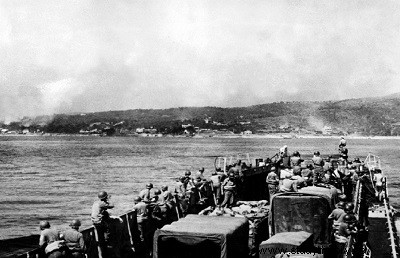
A swarm of Apex, small unmanned craft equipped with noisemakers, was then sent to the beaches to complete the work of the dredgers. The latter had already cleared the mines and obstructions of the channels near the beaches. The Apexes, packed with 10 tons of explosives each, were to blow up the last obstacles and mines near the shore.
After the noisemakers, 30,000 Whoofus rockets were fired from 40 landing craft tanks (L.C.T.) transformed, anchored a mile from the coast. The rockets were intended to blast mines buried in the sand. They were still whistling over the heads of the assailants at 8 a.m., when the first waves rushed from the 150 infantry landing craft (I.C.I.) to attack the beaches:it was the vanguard of the 90,000 soldiers who were to disembark that day.
In the Alpha Rouge sector (Cavalaire-sur-Mer), the assault waves of the 7th U.S. Regiment (3rd Division) waded into a beach covered with obstacles. The barrage of Whoofus fired for 8 minutes had many misfires and half the beach was still covered in still standing piles, a jungle of barbed wire and an unknown amount of buried mines which the Americans now had to deal with. . The ravaged beach seemed empty and for 20 minutes was silent. There seemed to be no one in the trenches that snaked along the shore.
Just as the sappers began to push through with Bangalores, the German mortars, 88s and machine guns opened fire from the heights. Other shots came from the thick pine woods lining the top of the beach. The Americans, in the open, suffered very many losses. Men who rushed for the protection of trees and bushes were killed by buried mines.
On Alpha Rouge, the 30th Division lost 203 men in all, the heaviest casualties suffered by the landing troops. The German response, vicious and deadly as it was, nevertheless came too late. Within an hour, Alpha Rouge was in American hands, as the assault troops and tanks that had fought their way up the beach and through the pine trees reached the coastal road.
Twenty kilometers further in the Alpha Jaune sector (Pampelonne), the American successes were much quicker. The German resistance had remained weak, it had consisted only of half-hearted artillery fire. In 40 minutes, the 15th regiment (3rd division) occupied Pampelonne without firing a shot. Along with the 756th Tank Battalion and the 601st Anti-Tank Battalion, he progressed through the brush behind the beach and steadily continued his advance along the main road to Saint-Tropez.
The relative ease and speed with which the beaches of the Alpha Sectors were conquered was quite characteristic of Operation "Dragoon" landings in general. La Nartelle, in the Delta sector (near Sainte-Maxime), was conquered a few minutes ahead of schedule, although the 157th U.S. Regiment (45th Division) ran into a formidable obstacle:a wall 3 meters high and two meters thick bordering the beach. The wall had withstood all the shelling, but the demolition companies overcame it with "S" mines. was 5 meters wide — the men of 157° supported by tanks, jeeps and armored vehicles, fought their way through gardens and vineyards to the road behind. As at Alpha Rouge, German resistance was violent but short-lived.
Around 9:15 a.m., 157° entered Sainte-Maxime. He discovered to his surprise that most of the Germans had left. Five hundred of them, with heavy trucks and armored vehicles had retreated by 8 a.m., leaving only a handful of snipers. By mid-morning, after two hours of house-to-house fighting, these last elements were silenced and Sainte-Maxime fell into American hands.
The Germans who had fled the town before the fact that the Allied troops did not land at La Nartelle testified to the discouragement that had gripped the greater part of the XIXth Army. And the malaise affected the highest ranks. No senior officer truly believed that an Allied invasion by sea could be contained, let alone repulsed.
By noon on August 15, the Allies had established strong bridgeheads and the 45th Division rushed inland to join up with the paratroopers around Le Muy. The latter had blocked all the roads leading to Sainte-Maxime and Saint-Raphaël, leaving no hope for the Germans to send reinforcements to these areas. Hitler had unnecessarily delayed the order to start the 11th Panzer Division until August 13. It was still in Avignon, 160 kilometers away, fighting for every inch of ground under the murderous harassment of the Allied air force.
The disastrous news from Provence, as well as the 'Alfred Jodl reported them to Hitler at his HQ in Rastenburg in East Prussia, were eloquent enough to convince the Führer that
the XIX Army could only be saved by withdrawing it immediately. Jodl, who was Hitler's main adviser on matters of strategy, had already prepared plans for the evacuation of France. At 12:45 p.m., Hitler gloomily approved them. He gave the order to block the ports, to scuttle the buildings, to destroy the weapons and the combustibles, and to withdraw the stores of supply towards the powerfully fortified ports of Marseilles and Toulon which were to remain occupied.
